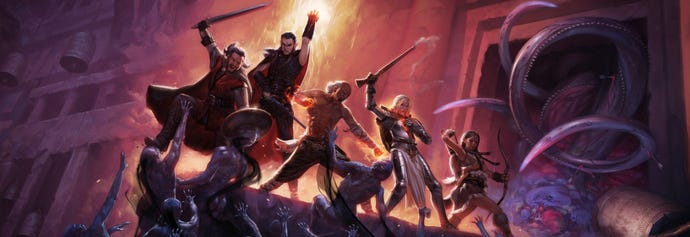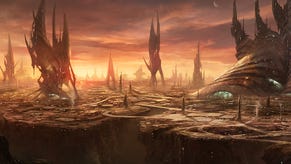Pillars of Eternity Review: Obsidian's Best RPG to Date
Pillars of Eternity evokes the halcyon days of isometric RPGs.
This article first appeared on USgamer, a partner publication of VG247. Some content, such as this article, has been migrated to VG247 for posterity after USgamer's closure - but it has not been edited or further vetted by the VG247 team.
Editor's note: Our review of Pillars of Eternity is now complete. You can find our score and our final thoughts on Page 2. For even more in-depth analysis, check out Axe of the Blood God — our official RPG podcast.
If you want to glimpse the roots of well-known RPGs like Fallout and Dragon Age, you need only look toward Pillars of Eternity — a kind of living time capsule for '90s PC RPGs.
Based on the Infinity Engine RPGs of the late '90s, Pillars of Eternity evokes Baldur's Gate, Icewind Dale, and Planescape Torment — all franchises Obsidian worked on back when they were still known as Black Isle Studios. For Obsidian, returning to that style is like coming home. They've made some great RPGs over the years, but Infinity Engine RPGs continue to be right in their wheelhouse.

"Pillars of Eternity was something we knew we could do, and we knew that... you knew... we could do," director Josh Sawyer told me when I previewed Pillars of Eternity last July. "We could pitch an Infinity Engine-style game made by the people who did Neverwinter, Temple of Elemental Evil, and Planescape and have people say, 'Yeah, I think you can do that."
Not surprisingly, despite technically being an original offering by Obsidian, Pillars of Eternity feels a great deal like the Dungeons & Dragons-based RPGs of old. Its rules are reminiscent of those in D&D 4th Edition, with some being available on a per encounter basis, and others only available after resting. As a result, properly rationing camping supplies is a big part of the strategy in Pillars of Eternity.
The flow of the combat should likewise be familiar to longtime PC RPG fans. When an encounter begins, the action pauses so that you can distribute orders to your party, at which point you can un-pause and watch the mayhem begin. Which is not to say that you can brute force your way through encounters. Pillars of Eternity kicks up the difficulty quite early, and if you're not careful, you can find yourself losing your squishy spellcasters early on and being quickly overwhelmed. It's hard enough, in fact, that Obsidian actually recommends that most people start on Easy, with Normal being reserved for veteran fans of the genre.

While occasionally frustrating, though, Pillars of Eternity's world is compelling enough that I've wanted to keep pressing onward. In true D&D fashion, it allows you to paint your own canvas to some extent, with many of the interactions being based on the race, background, and gender that you choose when rolling your character. It doesn't take long for the story to get rolling in earnest, with your character being imbued with the mysterious ability to gain insight into a stranger's past, making them a "Watcher."
The thing I like most about Pillars of Eternity thus far is how expansive it all feels. It isn't long before you reach Defiance Bay — a multi-part city that almost feels like it could be the setting for a game by itself, like Midgar in Final Fantasy VII or Kirkwall in Dragon Age II, but set in a much larger world. You also get your own fortress relatively early on, though unlike in Dragon Age: Inquisition, it's up to you to invest in building it up from scratch. Doing so confers benefits like unlocking bounties and attracting new heroes to your cause.
It's a really interesting game, and thus far, I have few complaints about its execution. The biggest problem I've had thus far has been with a game-breaking bug that I encountered late in Act 1. Playing as a Ranger, my wolf companion unexpectedly disappeared, and I found myself unable to go up stairs. It was bad enough that I actually had to start an entirely new game, which is why I'm only in Act 2 at the moment. Something to remember if you decide to roll up a Ranger.
Outside of that (admittedly rather large) quibble, I find myself intrigued by Pillars of Eternity. As someone who didn't really get into that style of RPG until the release of Dragon Age: Origins — itself a somewhat gimped Baldur's Gate — it's been interesting to go back to the heyday of isometric RPGs.
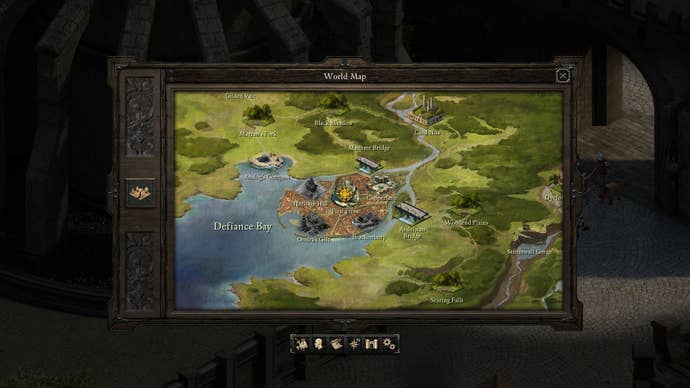
Does It Hold Up?
One question that's been on my mind since first hearing about Pillars of Eternity is, "Does the form hold up? Does the classical Infinity Engine RPG still work in an era dominated by open-world RPGs like Skyrim and Dragon Age: Inquisition?"
I'll just go ahead and answer my own question: Yes, it does. Pillars of Eternity is a superbly well-designed RPG, beautifully balancing a perfectly paced quest arc with impactful combat. It is one of the best RPGs that I've played in quite a while.
It begins with an intriguing mystery as your character gains the mysterious power to peer into the past of anyone they want, then rounds into a dark tale of stolen souls and experiments gone wrong, with an immortal antagonist pulling the strings. There's almost no padding to be found as it moves from peaceful forest paths to a horrifying sanitarium, the story moving as fast or as slow as you want. Most every story quest has an interesting hook of some sort, whether it involves figuring out why a village has been overrun by ghouls, or earning the trust of a faction ahead of citywide hearings.
In Axe of the Blood God, our RPG podcast, GamesBeat's Jason Wilson and I compared notes and realized that our experiences had been very different, but also compelling in their own way. Where he dove into every nook and cranny of the world, I opted to mostly stick to the storyline, moving through the quests at a comparatively brisk pace. Impressively, both approaches appear to be balanced and rewarding, and rarely did I feel like I was being forced to take on a quest that I did not want. Jason, meanwhile, found that there was plenty of content to satiate his appetite for exploration, pushing his total playtime well beyond 50 hours. That is some great RPG design right there.
In the meantime, while it does its best to capture a certain period of RPG history, Pillars of Eternity by no means feels dated. Powered by the Unity Engine, its comparatively simple visuals are buoyed by superb art and an outstanding soundtrack, both of which add considerable color to the world while keeping it fresh and interesting. Pillars of Eternity's combat, meanwhile, incorporates a variety of concepts from more modern iterations of Dungeons & Dragons, particularly versions 3.5 and 4.0.
While the A.I. has some issues with pathfinding and getting confused during battle — Jason likened combat to herding cats during our podcast — it is rarely a large issue. Mostly, I found myself enjoyed the varied encounters, which rarely degenerated into the rote slog that can occasionally infect this sort of game, where enemy mobs are mere stumbling blocks. Even on Easy, a mass of bad guys can make for quite a challenge, forcing you to carefully manage your magic and your party formation with the help of the pause function, which can be used to take a breather and take stock of your surroundings.
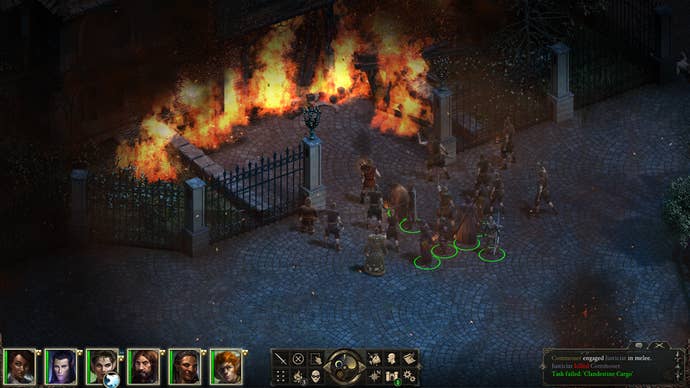
Magic is quite important in Pillars of Eternity; but happily, it doesn't feel too overpowered here. Rather, its power is balanced by its comparative scarcity, with the best spells only being available twice before having to be recharged around a campfire. Mages are also really squishy, which means they tend to be the definition of glass cannon — as it should it be, I might add. In general, I've really enjoyed Pillars of Eternity's combat. It offers pretty much everything I want in an RPG — it's balanced, it requires a good deal of tactical thinking, and it's fast-paced. And best of all, Pillars of Eternity supports up to six members per party, which is really the optimal number for an RPG such as this, affording maximum flexibility without becoming cumbersome.
Of the recruitable party members themselves, there are comparatively few standouts. You can find a mad priest, a dwarf ranger, and an elf-like mage with a split personality — all with their own individual quests to follow, but none of whom are destined to be fan favorites. Rather, they are mostly solid additions to the party, occasionally contributing a bit of witty banter and otherwise slotting neatly into their individual niches.
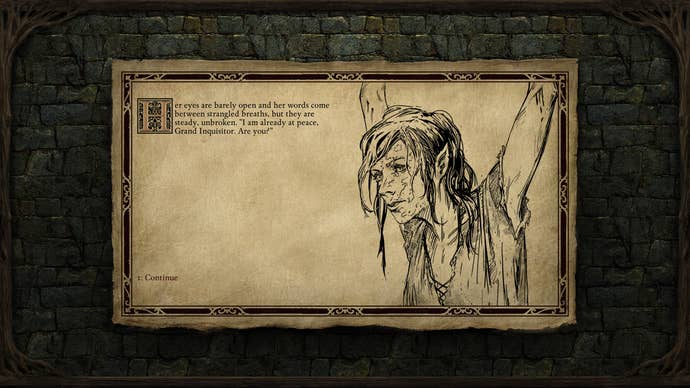
In some ways, Pillars of Eternity's available party members reflect the game itself. Though it is a large and well-designed game with a number of good ideas, it mostly sticks to established concepts, tweaking the formula without angering the core fans. Outside of that, it's only real failing is its player Stronghold, which adds a good deal of value but never really reflects the money being poured into it, remaining an old ruin even after multiple upgrades. But while it mostly declines to push the genre's envelope, it is still a damn fine RPG. Competing developers should be taking notes, because it is a master class of balanced combat and progression, with a dark and entertaining story to boot.
If Obsidian is to believed, Pillars of Eternity is the first in what will hopefully be a new series. If that's the case, then we're all richer for it. It's not been an easy road for Obsidian, who have occasionally struggled against the expectations of developing AAA RPGs. But in returning to their roots, they have produced their best RPG to date.
VisualsPillars of Eternity does exactly what it needs to do in terms of graphics, invoking the nostalgia of the Infinity Engine without looking dated. The character models are a little stiff and lack detail, but the environmental art more than makes up for it.
SoundPillars of Eternity boasts a rich, vibrant soundtrack reminiscent of <em>Lord of the Rings</em>. It is only partially voiced, but what audio is there is generally very good.
InterfaceAn easily accessible stash and crafting menu makes it easy to deal with items while enhancing existing weapons. The UI as a whole is attractive while also serving as a callback to the '90s PC RPGs its meant to represent.
Lasting AppealWith a large number of quests to complete and areas to explore, Pillars of Eternity can last up to 70 hours. The main quest, by contrast, will probably take about 35 hours to finish.
ConclusionPillars of Eternity is more than an appeal to nostalgia; it's a rich RPG in its own right, boasting enjoyable combat, a strong story, and masterfully paced quests. What flaws it has — poor pathfinding A.I. and a Stronghold that feels somewhat derserted — are comparatively minor in the grand scheme of things. Right now, its biggest problem is a surfeit of bugs, which seem endemic to Obsidian's RPGs. Ignoring all that, though, Pillars of Eternity is enormously entertaining, and may end up making a strong claim to being one of the best RPGs of the year.
